The purpose of this publication is to provide current management practices for diamondback moth in both conventional and organic cabbage. The intended target audience is Extension agents and growers, for whom we hope it will serve as a helpful guide.
Introduction
The diamondback moth (DBM), Plutella xylostella (Linnaeus), is a significant pest of cole crops such as cabbage, Chinese cabbage, broccoli, Brussels sprouts, collards, kale, kohlrabi, mustard, radish, carinata, turnips, and watercress. Globally, the annual cost of managing the DBM is estimated to be USD 4–5 billion (USDA ARS 2023). The pest originated in Europe but is now widely distributed wherever cole crops are extensively grown. DBM has become widespread due to its high dispersal ability and multiple generations per year. Management of this pest is difficult because of its potential to develop resistance to most commonly used insecticides. The pest causes significant yield losses when populations are uncontrolled. Warmer climates in the southern United States favor the breeding of up to 15 generations per year, while the northern parts with cooler climates support 3–4 generations per year. Changing climatic patterns appear to have exacerbated the DBM problem. DBM management is heavily reliant on chemical control. Due to the year-round presence of cultivated and wild cruciferous crops in the southern United States, continuous pesticide application and other pest management techniques are required. DBM is notorious for developing resistance to many classes of insecticides, and frequent pesticide applications can lead to insecticide resistance, ineffective pest suppression, and yield losses. Therefore, to manage DBM, a good integrated pest management (IPM) strategy is critical.
Description and Life Cycle
The DBM undergoes four life stages: egg, four larval instars, pupa, and adult. The duration of each stage depends on temperature, and the development time from the egg to the pupal stage averages 25 to 30 days. The adult DBM moths (see Figure 1) are slender, greyish-brown moths with antennae that point forward at rest (Borror and Delong 2014). When at rest, the light-colored pattern on their wings resembles three yellow diamond-shaped marks along the line where the wings meet, which gives them the name "diamondback moth." A female moth lays an average of 150 eggs over about 10 days (Capinera 2002). The eggs are laid singly or in small groups of two to eight eggs in depressions on the leaf surfaces. After hatching, the small, green larvae actively feed on the foliage (Figure 2). Pupation usually occurs on the lower side of the leaf surface inside a loosely spun cocoon (Figure 3).
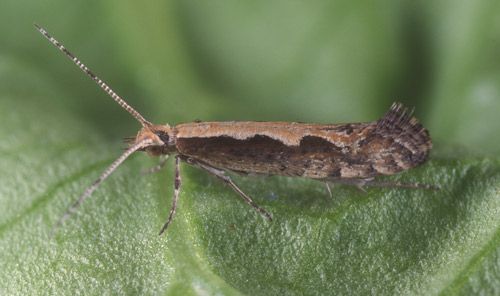
Credit: Lyle Buss, UF/IFAS
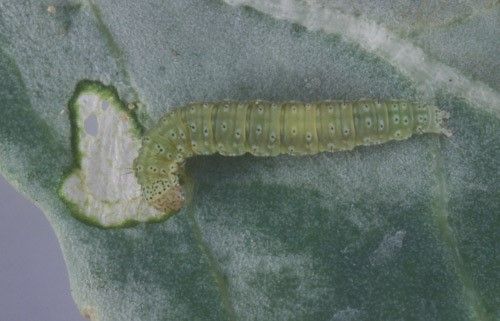
Credit: Lyle Buss, UF/IFAS

Credit: Lyle Buss, UF/IFAS
Crop Damage
The most damaging stage of this pest is the larvae. Crop injury occurs because of larval feeding or due to the presence of larvae contaminating produce (Philips et al. 2014). Early-instar larvae feed within leaves and create mines, while the later larval instars feed on the leaf surfaces creating leaf holes that expand to become "windowpanes" (see Figure 4 and Figure 5). Severe DBM infestations can lead to complete skeletonization of foliar tissues, which disrupts the formation of cabbage heads.
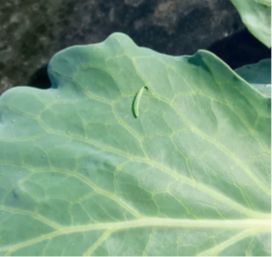
Credit: Kendi Muthomi, UF/IFAS
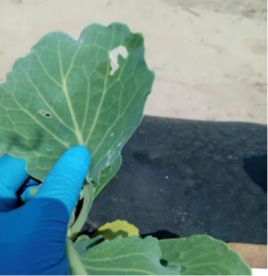
Credit: Kendi Muthomi, UF/IFAS
Host Plant Resistance
Planting cultivars that can tolerate or resist DBM damage is the first line of defense. For instance, cabbage cultivars with smooth, glossy leaves and a specific glucosinolate profile suffer less larval damage (Dickson et al. 1990; Robin et al. 2017). On glossy leaf surfaces, larvae spend less time feeding and more time searching for a suitable spot to feed (Dara 2021). Conversely, glucosinolates such as sinigrin and glucobrassicin attract DBM for oviposition (Shelton 2004), while sinalbin and glucocheirolin act as specific feeding stimulants for DBM. More than 40 plant species containing one or more of these compounds serve as hosts of DBM.
Management and Control
In Florida, managing DBM in cole crop production systems requires an integrated pest management (IPM) approach, whether conventional or organic. An effective IPM approach involves monitoring and the use of cultural, behavioral, biological, and chemical control methods.
Monitoring
Diamondback moth populations can be monitored by using in situ counts, observing random cabbage leaves in the field and visually counting larvae, or assessing plant damage (Philips et al. 2014). Unbaited yellow sticky traps and traps with pheromone lures specific to DBM can also be used to monitor field populations of DBM. When pest populations reach the economic threshold (ET), it is necessary to take management action to prevent further economic damage to the crop. Economic thresholds vary by region and state; e.g., Southeastern states generally have lower economic thresholds due to higher pest pressure, and it is recommended to start treatments at the early signs of feeding damage. In Virginia, scouting is recommended weekly, and treatment is advised if more than 20% of plants have at least one larva before head formation, and if more than 5% have at least one larva from heading to harvest (Cordero and Kuhar 2009).
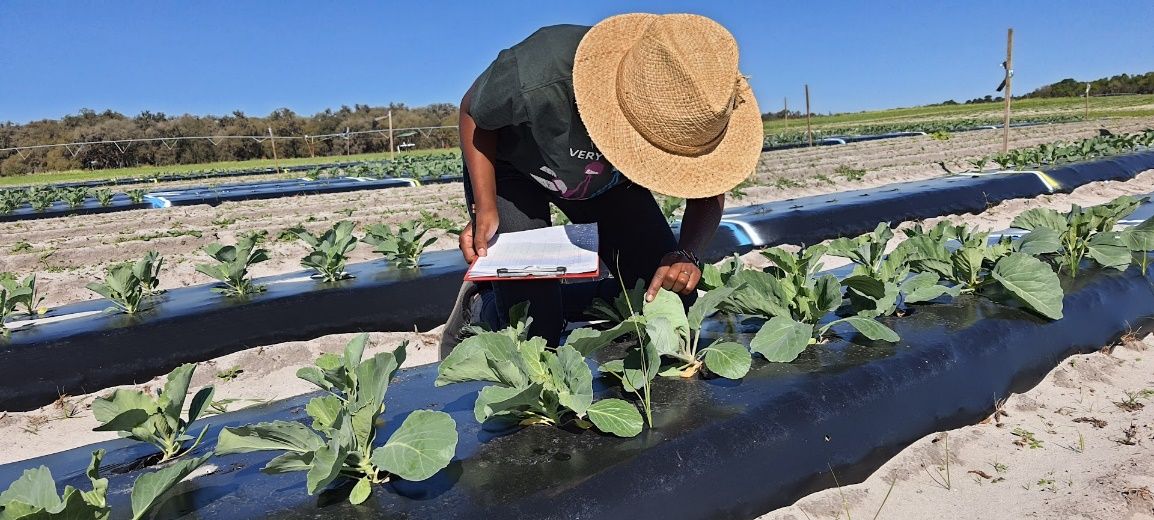
Credit: Kendi Muthomi, UF/IFAS
Cultural Control
This involves manipulating the crop environment to make it unfavorable for DBM while still maintaining the productivity of the crops. Cultural control helps conserve natural enemies such as predators and parasitoids within the crop system. Since DBM is fairly restricted to cruciferous crops, avoiding sequential plantings of these crops in the field can reduce population buildup and subsequent damage (Philips et al. 2014). Seasonal factors, such as rainfall, can influence pest abundance, so determining optimum planting time can be a great tool to limit DBM population growth. Vegetation diversity is also a significant technique in reducing DBM densities. Intercropping/mixed cropping of various vegetables maximizes the use of rotation, which helps limit the spread of many pests. Sanitation is also an important measure of pest control in cabbage fields. It involves the removal of alternate hosts, weed hosts, volunteer plants, and crop residues.
Biological Control
The presence of natural enemies in a cabbage field (predators and parasitoids) is crucial for regulating DBM populations (Sarfraz et al. 2007). There are more than 135 species of parasitoids worldwide known to target different stages of DBM (Delvare 2004), including six species of egg parasitoids, 38 larval parasitoids, and 13 pupal parasitoids. Some of these natural enemies include Trichogramma pretiosum (an egg parasitoid), Cotesia plutellae, Diadegma insulare, Diadromus subtilicornis, and Microplitis plutellae (all larval parasitoids), predatory ground beetles, hemipterans, syrphid fly larvae, and spiders. To conserve these natural enemies, it is recommended to plant insectary strips in the field and release commercially available natural enemies to maximize effective biological control of DBM.
Behavioral Control
Using semiochemicals for behavioral management presents a significant opportunity for DBM management. An effective way to manage DBM is through mating disruption using sex pheromones. This tactic confuses male moths and makes it difficult for them to find female mates, which can reduce mating and ultimately decrease the number of DBM in the next generation. A recent study in a commercial Brussels sprouts field demonstrated the potential of using a sprayable pheromone for mating disruption (Dara 2020).
A majority of semiochemical controlled-release formulations are applied using devices such as aerosol dispensers, polyethylene tubes, and laminated polymers. However, more advanced technologies such as SPLAT® formulations (Specialized Pheromone and Lure Application Technology) are under development and offer great potential in the application of semiochemicals for DBM control. SPLAT® formulations are controlled-release emulsions that hold a range of semiochemical concentrations and additives to create a formulation that releases the optimal rate of semiochemical over a specific period while protecting the active ingredients from environmental, chemical, and biological degradation (Mafra-Neto et al. 2013).
A study conducted in 2022 to evaluate the efficacy of a new DBM SPLAT® formulation in field conditions when combined with selected insecticides showed that treatments with SPLAT® had significantly higher yields and less damage on cabbage heads (Muthomi et al. unpublished data). While this technology shows promise, further research is needed to assess the long-term effectiveness of the technology in various field conditions.
Chemical Control
The most-used method for controlling DBM is the application of chemical pesticides of natural and synthetic origin. Naled (Dibrom), tolfenpyrad (Apta), emamectin benzoate (Proclaim), cyantraniliprole (Excirel), spinosad (Entrust®), plinazolin (ISM555SC200), and other synthetic pesticides from different modes of action can all be effective against DBM (Riley et al.2020; Seal and Sabines 2023; Palumbo 2023; Dunn et al. 2024). Similarly, in 2024, Mészáros, and Beuzelin investigated the efficacy of insecticides against DBM in collards and observed that broflanilide (Cinegra®) was effective in controlling DBM. In addition to chemical pesticides, vegetable oils, mineral oils, neem oil, and other botanical extracts can also be used as both ovicides and larvicides. In 2020, Mazlan investigated the potential of botanical extracts (Roselle) as an oviposition deterrent against DBM and observed that significantly fewer eggs were laid on cabbage leaf discs treated with Roselle Fruit Extracts (Mazlan et al. unpublished).
References
Borror, D. J., and D. M. DeLong. 2014. Introduction to the Study of Insects, 7th edition.Thompson, Brooks/Cole.
Capinera, J. L. 2002. “Diamondback Moth, Plutella xylostella (Linnaeus) (Insecta: Lepidoptera: Plutellidae): EENY-119 IN276, Rev. 5 2000.” EDIS 2002 (8). Gainesville, FL. https://doi.org/10.32473/edis-in276-2000.
Cordero, R., and T. Kuhar. 2009. Diamondback Moth in Virginia. Virginia Cooperative Extension Publication, 444–007.
Dara, S. K. 2020. “Mating Disruption as an IPM Tool in Diamondback Moth Management.” UCANR eJournal of Entomology and Biologicals. Available at: https://ucanr.edu/blogs/blogcore/postdetail.cfm?postnum=44160
Dara, S. K. 2021. “Integrated Pest Management Strategy for the Diamondback Moth, Plutella xylostella.” UCANR eJournal of Entomology and Biologicals. Available at: https://ucanr.edu/blogs/blogcore/postdetail.cfm?postnum=51111
Delvare, G. 2004. “The Taxonomic Status and Role of Hymenoptera in Biological Control of DBM, Plutella xylostella (L.). In: A.A. Kirk & D. Bordat, eds. Improving biocontrol of Plutella xylostella: Proceedings of the International Symposium, Montpellier, France, 21–24 October 2002. Montpellier: CIRAD, USDA-ARS, pp. 17–49.
Dickson, M. H., A. M. Shelton, S. D. Eigenbrode, and M. L. Vamosy. 1990. “Selection for Resistance to Diamondback Moth (Plutella xylostella) in Cabbage.” HortScience 25 (12):1643–1646. https://doi.org/10.21273/HORTSCI.25.12.1643
Dunn, T. P., P. S. G. Cremonez, A. Furuya, A., et al. 2024. “Regional Changes of Maximum Dose Insecticide Responses in Diamondback Moth (Lepidoptera: Plutellidae) Populations from Georgia and Florida, USA.” Journal of Economic Entomology. https://doi.org/10.1093/jee/toae218
Mafra-Neto, A., F. M. de Lame, C. J. Fettig, et al. 2013. “Manipulation of Insect Behavior with Specialized Pheromone and Lure Application Technology (SPLAT®).” In Pest Management with Natural Products (pp. 31–58). American Chemical Society. https://doi.org/10.1021/bk-2013-1141.ch004
Mészáros, A., and J. M. Beuzelin. 2024. “Field Efficacy of Insecticides for Control of the Diamondback Moth in Collards in Southern Florida.” Arthropod Management Tests 49 (1) tsae106. https://doi.org/10.1093/amt/tsae106
Palumbo, J. C. 2023. “Insecticide Bioassay against Diamondback Moth Adults.” Arthropod Management Tests 48 (1): tsad108 https://doi.org/10.1093/amt/tsad108
Philips, C. R., Z. Fu, T. P. Kuhar, A. M. Shelton, and R. J. Cordero. 2014. “Natural History, Ecology, and Management of Diamondback Moth (Lepidoptera: Plutellidae), with Emphasis on the United States.” Journal of Integrated Pest Management 5 (3): D1–D11. https://doi.org/10.1603/IPM14012
Riley, D., H. Smith, J. Bennett, et al. 2020. “Regional Survey of Diamondback Moth (Lepidoptera: Plutellidae) Response to Maximum Dosages of Insecticides in Georgia and Florida.” Journal of Economic Entomology 113 (5): 2458–2464. https://doi.org/10.1093/jee/toaa125
Robin, A. H. K., M. R. Hossain, J. I. Park, H. R. Kim, and I. S. Nou. 2017. “Glucosinolate profiles in cabbage genotypes influence the preferential feeding of diamondback moth (Plutella xylostella).” Frontiers in Plant Science 8:1244. https://doi.org/10.3389/fpls.2017.01244
Sarfraz, M., A. B. Keddie, and L. M. Dosdall. 2007. “Biological Control of the Diamondback Moth, Plutella xylostella: A Review.” Biocontrol Science and Technology 15 (8): 763–789. https://doi.org/10.1080/09583150500136956
Seal, D. R., and C. Sabines. 2023. “Control of Diamondback Moth in Cabbage, Spring 2022.” Arthropod Management Tests 48 (1): tsad090. https://doi.org/10.1093/amt/tsad090
Shelton, A. M. 2004. “Management of the diamondback moth: déjà vu all over again?” InThe Management of Diamondback Moth and Other Crucifer Pests: Proceedings of the Fourth International Workshop, edited by N. M. Endersby and P. M. Ridland. Melbourne, Australia, 26–29 November 2001. Melbourne: Department of Natural Resources and Environment, pp. 3–8
United States Department of Agriculture, Agricultural Research Service (USDA ARS), 2023. Diamondback Moth Project. https://www.ars.usda.gov/office-of-international-research-engagement-and-cooperation/ebcl/research/diamondback-moth-project/